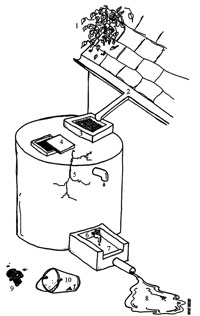16.7 Sanitary survey of rainwater collection and storage
As you learned in Study Session 15, rainwater harvesting is applicable for areas that have a shortage of other water sources. The roof from which rain is collected should be free from contaminants. There also needs to be a clean and well-constructed tank with no cracks in the walls and a properly covered inspection hole. Figure 16.5 shows what you should be looking for when you are doing a sanitary survey of rainwater collection and Box 16.3 has a list of questions to be asked. As before the numbers in the diagram demonstrate particular points and correspond to the checklist of questions. Any ‘yes’ answers would be a cause for concern.

Box 16.3 Sample checklist for rainwater collection and storage inspection
Name of Health Post ------------
Village name ------------
Questions to be asked during survey:
- Does the roof have any visible contaminants (plants, dirt or excreta)?
- Are the guttering channels that collect the water dirty?
- Does the filter box at the tank inlet have any defects that could let in fine dusts?
- Does the tank have any other point of entry which is not properly covered?
- Do the walls or top of the tank have cracks or holes that could let water in?
- Does the tap leak or have any defects?
- Does the concrete floor under the tap have any defects?
- Does the water collection area drain inadequately?
- Does the area around the tank or water container have any source of pollution like faeces?
- If a bucket is in use and left in place, is it exposed to contamination?
Name ------------
Signature ------------
Date ------------
16.6 Sanitary survey of springs
